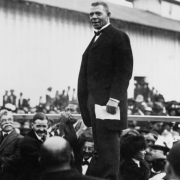The Declaration of Independence was signed and executed during an armed revolt against a despotic monarch. The document listed numerous transgressions by the King against the natural rights of his citizens, their collateral oppression, and the de facto forfeiture of sovereignty by the King. While the member States were to exercise self-government under the Articles of Confederation, that failed after a few years, and a federal-style republic was formed under the Constitution.
A primary reason for the revolt was religious freedom. Protestants had migrated to live and worship as they saw fit, and were eventually joined by Jews trying to escape religious persecution. Their spirit of independence, self-reliance, and industry eventually created a vibrant middle class of shop keepers, lawyers, doctors, ministers, industrialists, and bureaucrats. Social mobility was finally possible, and lower class laborers enjoyed a relatively higher standard of living. Combined with an advantageous geographic location for international trade, it became the wealthiest and most scientifically advanced society in the world. Once a luxury reserved only for elite aristocrats, leisure time became commonplace.
This unprecedented accumulation of wealth, including many well-heeled entrepreneurs, freed capital for tremendous works of fine art. The creative genius of great artists was unleashed, and they produced images for the entire world to see how life could and should be lived. Of course, this was the Dutch Golden Age of the 1600s and early 1700s; and among the greatest of these Dutch Masters was Poetic Justice Warrior Johannes Vermeer.
A Romantic Sense of Life
Vermeer was uniquely talented in the two most basic elements of great art – subject and style. These two choices are separate, become integrated by fine artists, and reveal their sense of life. The subject an artist chooses is a declaration of what they believe to be notable. For example, a human subject can be virtuous, a mediocrity, or depraved. For Vermeer, his subjects were at peace because they were free to engage in the activities of daily living, social engagement, and creative work. Very rare in annals of human history, they were not desperately striving for a meager existence, or spellbound by the sinister projections of wannabe despots.
One of Vermeer’s remarkable achievements was to draw the observer into the canvas of his paintings, imagine the contemplations of his subjects, and experience the soothing textures of their surroundings. This brings us to an even greater achievement: Vermeer’s unique style was more than visual perception, it was a non-visual abstraction. In her 1971 collection of essays titled The Romantic Manifesto, Ayn Rand describes Vermeer’s genius.
He has isolated the essential, distinguishing characteristics, and integrated them into a single visual unit. To the operations of a single sense organ, the organ of sight. What his style projects is clarity, discipline, confidence, purpose, power. A universe open to man.
The distinguishing characteristic of Vermeer’s paintings was his portrayal of pure, radiant, austere light. In fact, the placement of the people, tapestries, furniture, wall hangings, and windows serve this stylistic purpose. It is this combination of subject and style that expose the Poetic Justice of Johannes Vermeer’s sense of human consciousness, our life’s efficacy, and its proper method of functioning. Reason, purpose, pride.
The Hole in the Box
Like The Astronomer uses a telescope to magnify and clarify the natural light of celestial bodies, Vermeer used the technology of his day to clarify the natural light that illuminated the space occupied by his subjects. Known as camera obscura, it was a box whose interior was painted white, and was equipped with a lens and mirrors that intensified the light and shadows they reflected.
This tool was also essential for him to capture the fine details of the cloth and other objects with his vibrant color palette and brush strokes. More importantly, it helped prime the neural flow between Vermeer’s conscious mind and its subconscious framework, and produce great works of art that exceed their photographic quality. Or as Arthur K. Wheelock, former curator of the National Gallery of Art observes,
Vermeer is one of those rare artists whose works transcend the limits of time and place. His images, whether a young girl in an exotic turban, an intimate ensemble in a sunlit interior, or a view across a quiet street, have an immediacy that is as vivid today as it was to viewers in seventeenth-century Delph.
The countless hues and qualities of light transmitted by his subjects entered the hole in the box from one side, and reflected through Vermeer’s eyes from another side. Four hundred fifty years later, we also peer into the hole in the box (the picture frame) and observe the light the painting reflects. But instead of witnessing the exact reality of the past, we see his integration of the philosophical themes that were essential to him. For example, in Officer and the Laughing Girl, as Wheelock explains,
Vermeer uses the sunlight falling on her to enliven her expression and to create shimmering highlights. He furthered this effect by dressing the soldier in deep red, a color associated with passion and power. He used the dramatic perspective of the window frame to draw the viewer into the scene.
Like John Harrison, a century later, harnessed the fourth dimension of time to solve the three dimensional problem of longitude, Vermeer harnessed the time inherent to space, light, and his creative activity to project his abstract conceptualization of reality into the future.
Time and Economic Freedom
During his lifetime, at least until 1672 (when Catholic-dominated France invaded The Netherlands and the art market collapsed), Vermeer lived comfortably. He was a local celebrity, enjoyed the moral sanction of his work, and painted his amazing details very slowly. His low time preference is a wonderful testament to the entrepreneurial culture of the Dutch Golden Age.
Because of the economic freedom they earned with independence, North Netherlands became the nerve center for commerce and banking, the wealthiest state in Europe, and the light of the world. The new country’s understanding of the nature of time, in particular the time value of money. Its moral sanction of interest on loans was becoming a primary value. As Austrian economist Eugen Bohm von Bawerk reveals in his 1884 book Capital and Interest,
Among the ever increasing adherents of the new theory, stands out prominently the renowned and influential lawyer Gerhard Noodt, who in his three books discusses the whole interest question very thoroughly, and with great knowledge of facts and literature.
Surrounded by church dominated English and French cultures that literally demonized interest, and the heavy cost of taxes to fund wars, the Dutch economic empire eventually fell apart. It wasn’t until a century later that French economist Robert Jacques Turgot recognized interest on loans as the equivalent of property rights. In the meantime, Vermeer had become heavily indebted, died in 1675, and fell into obscurity. As Poetic Justice would have it, Vermeer’s works were rediscovered in the 1800s.
In our postmodern world of bastardized money, vilified profit, lionized mediocrity, and the recent suspension of daily, life-sustaining creative work, we would be well served to contemplate Johannes Vermeer’s romantic sense of life. To sanction the independent virtues intrinsic to such a society, as it could and should be; and to free ourselves of the sinister projections of wannabe despots.












